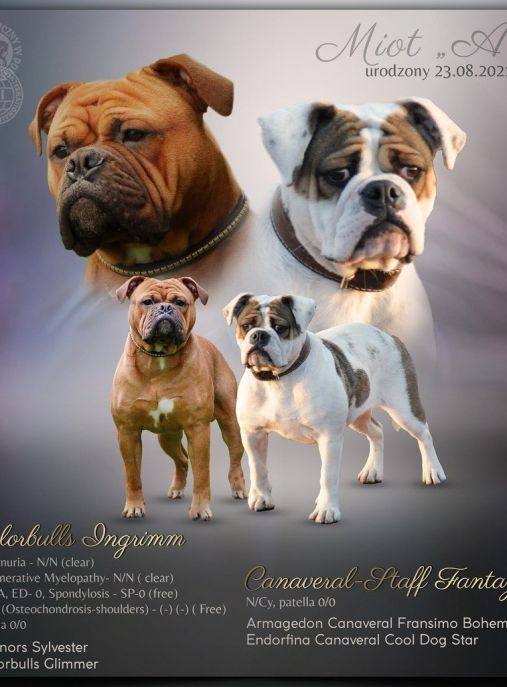The Continental Bulldog, also known as Conti or Swiss Bulldog, is a medium-sized dog breed that is known for its muscular build and distinctive appearance. With its strong and sturdy physique, this breed exudes power and strength. The Conti Bulldog is characterized by its large head, broad shoulders, and a compact body. Its expressive face is adorned with a wrinkled forehead, a short muzzle, and a well-defined jawline. The breed's eyes are round and dark, giving it an alert and intelligent expression.
The history of the Continental Bulldog can be traced back to the 19th century when breeders in Switzerland and Germany aimed to create a healthier and more functional version of the English Bulldog. By selectively breeding Bulldogs with other breeds such as the Boxer and the Olde English Bulldogge, they successfully developed the Continental Bulldog. This breed was primarily bred for working purposes, including guarding, herding, and driving cattle.
According to the FCI (Fédération Cynologique Internationale) typology, the Continental Bulldog belongs to Group 2: Pinscher and Schnauzer - Molossoid breeds - Swiss Mountain and Cattle Dogs. Within this group, it falls under Section 2.1: Molossoid breeds, Mastiff type. This classification highlights the breed's heritage and its close relation to other Molossoid breeds.
The Continental Bulldog is a versatile breed that can adapt to various roles and environments. While it still possesses the guarding instincts of its ancestors, it has also become a beloved companion and family dog. Its gentle and affectionate nature makes it an excellent choice for families with children. Additionally, its intelligence and trainability make it suitable for various dog sports and activities.
In terms of physical characteristics, the Continental Bulldog typically weighs between 55 to 77 pounds (25 to 35 kilograms) for males and 44 to 66 pounds (20 to 30 kilograms) for females. The height at the withers ranges from 19 to 22 inches (48 to 56 centimeters) for males and 18 to 21 inches (45 to 53 centimeters) for females. The life expectancy of the Continental Bulldog is around 10 to 12 years.
One interesting fact about this breed is its ability to adapt to different climates. Despite its muscular build, the Continental Bulldog is not prone to overheating and can comfortably live in both hot and cold environments. This adaptability is attributed to its short coat, which requires minimal grooming. The coat is smooth and dense, providing adequate protection without excessive shedding.
Another notable characteristic of the Continental Bulldog is its friendly and sociable nature. It tends to get along well with other dogs and animals, making it a suitable choice for multi-pet households. However, early socialization and proper training are essential to ensure good behavior and prevent any potential dominance issues.
In conclusion, the Continental Bulldog is a remarkable breed that combines strength, intelligence, and a gentle temperament. Its history as a working dog has shaped its physical attributes and versatile nature. Whether as a loyal companion or a reliable working partner, the Conti Bulldog continues to win the hearts of dog enthusiasts worldwide.
The Continental Bulldog, also known as Conti or Swiss Bulldog, is a breed of dog that possesses a unique and distinctive character. These dogs are known for their friendly and affectionate nature, making them excellent companions for families and individuals alike. In this text, we will delve into the character of Continental Bulldogs, discussing their behavior, how to raise them, and the best methods for training them.
One of the most prominent traits of the Continental Bulldog is their gentle and loving disposition. They are incredibly loyal and form strong bonds with their owners, often seeking their attention and affection. These dogs thrive on human companionship and are happiest when they are a part of the family unit. They are known to be excellent with children, displaying patience and tolerance towards them. However, it is important to supervise interactions between young children and dogs to ensure the safety of both parties.
Continental Bulldogs are generally calm and easygoing, making them suitable for various living situations. They adapt well to apartment living as long as they receive regular exercise and mental stimulation. Despite their relaxed nature, they have a playful side and enjoy engaging in activities with their owners. Regular walks, playtime, and interactive toys are essential to keep them physically and mentally stimulated.
When it comes to training, Continental Bulldogs are intelligent and eager to please. They respond well to positive reinforcement techniques such as praise, treats, and rewards. Harsh training methods or punishment should be avoided as it can lead to fear or anxiety in these sensitive dogs. Consistency and patience are key when training a Continental Bulldog, as they may be stubborn at times. Early socialization is crucial to ensure they grow up to be well-rounded and confident dogs.
Continental Bulldogs have a moderate energy level and require regular exercise to maintain their physical and mental well-being. Daily walks, play sessions, and interactive games are necessary to prevent boredom and destructive behavior. They enjoy participating in various activities such as obedience training, agility, and even swimming. However, it is important to avoid excessive exercise, especially during hot weather, as they are prone to overheating due to their short muzzle.
In terms of grooming, Continental Bulldogs have a short and smooth coat that requires minimal maintenance. Regular brushing will help keep their coat clean and remove any loose hair. They are average shedders and do not require frequent baths unless necessary. It is important to pay attention to their facial wrinkles and keep them clean and dry to prevent any skin issues.
In conclusion, the Continental Bulldog is a loving, loyal, and adaptable breed that makes an excellent companion for individuals and families. They thrive on human companionship and are known for their gentle nature. With proper training, socialization, and exercise, these dogs can grow up to be well-behaved and happy pets. If you are looking for a friendly and affectionate dog that will bring joy to your life, the Continental Bulldog may be the perfect choice for you.
The Continental Bulldog, also known as the Conti or Swiss Bulldog, is a medium-sized breed with a muscular build and a distinctive wrinkled face. These dogs are known for their friendly and affectionate nature, making them great companions for families and individuals alike. To ensure the well-being of your Continental Bulldog, it is important to provide them with proper care and attention. Here are some tips on how to care for dogs of this breed:
1. Exercise: Continental Bulldogs are moderately active dogs that require regular exercise to maintain their physical and mental health. Daily walks, playtime, and interactive toys can help keep them engaged and prevent boredom. However, avoid excessive exercise, especially in hot weather, as these dogs are prone to overheating.
2. Grooming: The Conti's short coat is relatively low-maintenance, but regular brushing will help keep it clean and free from loose hair. Use a soft-bristle brush or a grooming mitt to remove any dirt or debris. Pay special attention to the wrinkles on their face, as they can accumulate moisture and become a breeding ground for bacteria. Clean the wrinkles gently with a damp cloth and ensure they are thoroughly dried afterward.
3. Feeding: Provide your Continental Bulldog with a balanced and nutritious diet to support their overall health. Choose high-quality dog food that is appropriate for their age, size, and activity level. Avoid overfeeding, as these dogs have a tendency to gain weight, which can lead to health issues such as joint problems and obesity. Consult with your veterinarian to determine the right portion sizes and feeding schedule for your Conti.
4. Health care: Regular veterinary check-ups are essential to monitor your dog's health and detect any potential issues early on. Vaccinations, parasite prevention, and dental care should be a part of their routine healthcare. Continental Bulldogs are prone to certain health conditions, including hip dysplasia, allergies, and respiratory problems. Stay vigilant for any signs of discomfort or unusual behavior and seek prompt veterinary attention if needed.
5. Socialization and training: Continental Bulldogs are sociable dogs that thrive on human companionship. Early socialization is crucial to help them develop good behavior and adapt to various environments. Expose them to different people, animals, and situations from a young age. Positive reinforcement training methods work best with this breed, as they respond well to praise and rewards. Be patient, consistent, and firm in your training approach.
6. Environment: Provide your Conti with a comfortable and safe living environment. They can adapt well to apartment living as long as they receive adequate exercise and mental stimulation. Ensure they have a cozy bed, access to fresh water, and a quiet place to rest. Avoid leaving them alone for extended periods, as they can become anxious or bored. Consider crate training as a way to provide them with a secure space when you're not around.
What not to do:
1. Do not leave your Continental Bulldog alone in hot or humid conditions, as they are prone to heatstroke. Provide them with shade, fresh water, and avoid strenuous activities during peak temperatures.
2. Avoid overexerting your Conti during exercise, especially when they are young or in hot weather. Their short snouts make them susceptible to breathing difficulties, so monitor their breathing and take breaks as needed.
3. Do not neglect their dental hygiene. Regularly brush their teeth and provide them with appropriate chew toys to prevent dental issues.
4. Avoid using harsh training methods or punishment, as it can lead to fear or aggression in this sensitive breed. Positive reinforcement and consistency are key to successful training.
5. Do not ignore any signs of discomfort or health issues. Seek veterinary care promptly if you notice any changes in behavior, appetite, or physical condition.
By following these care tips and providing your Continental Bulldog with love, attention, and proper care, you can ensure they lead a happy and healthy life.
The Continental Bulldog, also known as the Conti or Swiss Bulldog, is a magnificent breed that possesses a wide range of coat colors. However, there is one common color that is often associated with this breed, and that is the striking brindle pattern.
Brindle is a unique and captivating coloration that can be seen in many Continental Bulldogs. It is characterized by a base coat color, usually fawn or white, with dark stripes or patches that are often black or a deep shade of brown. The brindle pattern can vary in intensity and distribution, creating a mesmerizing and eye-catching appearance.
The fawn base color of the Continental Bulldog's coat is typically a warm and rich shade, resembling a sandy or light tan hue. This color provides a beautiful canvas for the dark brindle stripes to stand out and create a stunning contrast. The fawn color can vary in intensity, ranging from a pale cream to a deeper reddish-brown tone.
The dark brindle stripes or patches that adorn the Continental Bulldog's coat are what truly make this breed stand out. These stripes can vary in thickness and shape, creating a unique pattern on each individual dog. The stripes can be evenly distributed throughout the body or concentrated in certain areas, such as the back, sides, or face. Some Continental Bulldogs may even have brindle markings on their ears or tail, adding to their overall charm.
The dark stripes of the brindle pattern can be black, giving the coat a bold and striking appearance. In some cases, the stripes may appear in shades of brown, ranging from a deep chocolate to a mahogany color. These variations in the brindle pattern contribute to the individuality and beauty of each Continental Bulldog.
It is important to note that while brindle is a common color in Continental Bulldogs, it is not the only color seen in this breed. They can also come in solid colors such as fawn, white, or a combination of both. Additionally, some Continental Bulldogs may have a black mask or markings on their face, adding another layer of uniqueness to their appearance.
In conclusion, the common color of Continental Bulldogs is the captivating brindle pattern. This coloration consists of a fawn base coat with dark stripes or patches that can be black or shades of brown. The brindle pattern varies in intensity and distribution, creating a visually stunning and distinctive appearance for this remarkable breed.
The Continental Bulldog, also known as Conti or Swiss Bulldog, is a medium-sized breed known for its muscular build, strong jaw, and distinctive wrinkled face. While generally a healthy breed, like any other, they are prone to certain health issues that owners should be aware of. Proper care and regular veterinary check-ups are essential to ensure the overall well-being of these dogs.
One of the most common health concerns in Continental Bulldogs is hip dysplasia. This condition occurs when the hip joint does not develop properly, leading to discomfort, lameness, and arthritis. Regular exercise on soft surfaces, maintaining a healthy weight, and avoiding excessive jumping can help reduce the risk of hip dysplasia. Additionally, breeders should perform hip evaluations on their breeding dogs to minimize the occurrence of this condition in future generations.
Another prevalent health issue in this breed is cherry eye, which is the prolapse of the gland of the third eyelid. This condition causes a red, swollen mass to protrude from the corner of the eye, leading to irritation and potential infection. Surgical correction is often necessary to reposition the gland and prevent further complications.
Respiratory problems are also common in Continental Bulldogs due to their short snouts and brachycephalic features. These dogs may suffer from brachycephalic airway syndrome, which includes conditions like stenotic nares (narrowed nostrils), elongated soft palate, and everted laryngeal saccules. These issues can cause difficulty breathing, snoring, and exercise intolerance. In severe cases, surgical intervention may be required to improve the dog's quality of life and prevent respiratory distress.
Skin allergies and dermatitis are frequently observed in Continental Bulldogs. They may develop allergies to certain foods, environmental factors, or even fleas. Regular grooming, including cleaning the skin folds and ears, can help prevent infections and manage allergies. A balanced diet with high-quality ingredients and avoiding known allergens can also contribute to maintaining healthy skin.
Like many other breeds, Continental Bulldogs are susceptible to various genetic disorders, such as congenital heart defects, eye problems (including cataracts and progressive retinal atrophy), and certain types of cancer. Responsible breeders should conduct thorough health screenings on their breeding dogs to minimize the risk of passing on these conditions to offspring.
To care for the health of a Continental Bulldog, regular veterinary check-ups are crucial. Vaccinations, parasite prevention, and dental care should be a part of their routine healthcare. A balanced diet, appropriate exercise, and maintaining a healthy weight are essential for their overall well-being. Avoiding extreme temperatures and providing a comfortable living environment are also important, as these dogs can be sensitive to heat and cold.
In conclusion, while Continental Bulldogs are generally healthy dogs, they are prone to certain health issues that owners should be aware of. Regular veterinary care, proper nutrition, exercise, and a safe living environment are key to ensuring their optimal health and well-being. By being proactive and attentive to their specific needs, owners can help their Continental Bulldogs live long, happy, and healthy lives.
The Continental Bulldog, also known as Conti or Swiss Bulldog, is a medium-sized breed with a muscular build and a friendly, affectionate nature. When it comes to their nutrition, providing a well-balanced diet is essential to ensure their overall health and well-being. Here is an extensive description of the nutrition requirements for Continental Bulldogs, along with advice on feeding and things to avoid.
Protein is a crucial component of a Continental Bulldog's diet as it helps in muscle development and repair. High-quality animal-based proteins such as chicken, turkey, beef, and fish should form the foundation of their meals. Look for dog food that lists a specific meat source as the first ingredient, avoiding products that contain meat by-products or fillers.
Fat is another important nutrient for Continental Bulldogs, providing them with energy and aiding in the absorption of fat-soluble vitamins. However, it is crucial to maintain a balance and avoid excessive fat intake, as this breed is prone to weight gain. Opt for dog food that contains moderate levels of healthy fats, such as omega-3 fatty acids found in fish oil or flaxseed, which promote a healthy coat and skin.
Carbohydrates are a source of energy for dogs, but it's important to choose complex carbohydrates that are easily digestible. Whole grains like brown rice, oats, and quinoa are excellent options. Avoid dog foods that contain excessive amounts of corn, wheat, or soy, as these ingredients can cause allergies or digestive issues in some dogs.
Fruits and vegetables are beneficial for Continental Bulldogs as they provide essential vitamins, minerals, and antioxidants. Incorporate a variety of these into their diet, including carrots, sweet potatoes, blueberries, and spinach. However, be cautious with certain fruits like grapes and raisins, as they can be toxic to dogs.
Feeding frequency and portion control are crucial for maintaining a healthy weight in Continental Bulldogs. Puppies require more frequent meals, typically three to four times a day, while adult dogs can be fed twice a day. Consult with your veterinarian to determine the appropriate portion sizes based on your dog's age, weight, and activity level.
Avoid overfeeding your Continental Bulldog, as they have a tendency to gain weight easily. Obesity can lead to various health issues, including joint problems and heart disease. Monitor their body condition regularly and adjust their food intake accordingly.
While treats can be a great way to reward your dog, it's important to choose healthy options and limit their quantity. Opt for treats that are low in calories and made with natural ingredients. Avoid giving them table scraps, as some human foods can be toxic to dogs, such as chocolate, onions, garlic, and certain artificial sweeteners.
Lastly, always provide fresh, clean water for your Continental Bulldog. Hydration is essential for their overall health and helps maintain proper organ function.
In conclusion, a well-balanced diet is crucial for the health and well-being of Continental Bulldogs. Focus on high-quality proteins, moderate amounts of healthy fats, easily digestible carbohydrates, and a variety of fruits and vegetables. Avoid excessive fat intake, fillers, and ingredients that may cause allergies or digestive issues. Monitor portion sizes, avoid overfeeding, and choose healthy treats. By following these guidelines, you can ensure that your Continental Bulldog receives the nutrition they need to thrive.








